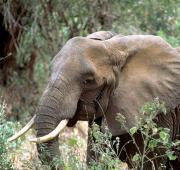 African Forest Elephant Classification and Evolution
African Forest Elephant Classification and EvolutionThe African Forest Elephant is one of two Elephant subspecies found on the African continent. Although the African Forest Elephant is slightly smaller than the African Bush Elephant, it is still one of the largest animals found on land today. Although these two Elephant species are very similar, the African Forest Elephant is thought to have rounder ears and straighter tusks than the African Bush Elephant, and it has been also noted that the African Bush Elephant and the African Forest Elephant have a different number of toe nails. Until recently though, they were considered to be the same species.
 African Forest Elephant Anatomy and Appearance
African Forest Elephant Anatomy and Appearance
The African Forest Elephant is the one of the largest known land mammals on Earth, with male African Forest Elephants reaching nearly 3 metres in height and the female African Forest Elephants around 2.5 metres. The tusks of an African Forest Elephant can grow to nearly 1.5 meters long and generally weigh between 50 and 100 pounds, which is about the same as a small adult Human. They are thinner, straighter and shorter than the tusks of the African Bush Elephant. African Forest Elephants have four molar teeth each weighing about 5.0 kg and measuring about 12 inches long. They have large rounded ears which are used both for hearing and to keep them cool.

The African Forest Elephant mainly lives in central and southern Africa in nomadic herds that wander through the forests and grasslands of Africa grazing for food and searching for waterholes. They are most commonly founds in the tropical dense jungles, where their smaller size allows them to move through the thick vegetation more easily than the larger African Bush Elephant. African Forest Elephants are threatened throughout much of their natural habitat today mainly due to deforestation and climate change and have been pushed into smaller and smaller pockets of their native lands.

The African Forest Elephant mainly uses it's immense tusks for digging for roots in the ground and to strip the bark off trees. The African Forest Elephant also uses it's tusks to defend itself from predators such as Lions, and to fight with other male African Forest Elephants during the mating season. Males are generally fairly solitary but females and their young form small family groups known as herds. This allows the more vulnerable offspring to be more easily protected. African Forest Elephants communicate through a series of low-frequency calls which they are able to detect from a few kilometres away.
African Forest Elephant Reproduction and Life Cycles
Female African Forest Elephants reach sexual maturity (are able to reproduce) after 10 or 11 years, and male African Forest Elephants often don't reach sexual maturity until they are nearly 20 years old. After a gestation period of up to 2 years, the female African Forest Elephant gives birth to a single calf (twins have been known but are extremely rare). The African Forest Elephant calf is nursed for 2 years and will remain with the herd until it is old enough to support itself. It is at this point that the tusks of the African Forest Elephant calf will be starting to grow.
African Forest Elephant Diet and Prey
The African Forest Elephant is a herbivorous animal meaning that it only eats plants and other vegetation. They predominantly eat leaves and fruit from trees, herbs and low-lying shrubs. However, the front pair of molars in the mouth of the African Forest Elephant wear down and drop out in pieces, making the back pair shift forward and two new molars emerge in the back of the African Forest Elephant's mouth. African Forest Elephants replace their teeth six times during their lives but when the African Forest Elephant is about 40 to 60 years old, the African Forest Elephant no longer has teeth and will likely die of starvation, which is sadly a common cause of death in the African wilderness.
African Forest Elephant Predators and Threats
The African Forest Elephant has no real natural predators to threaten its survival, mainly due to the African forest elephant's sheer size. However, it is not uncommon for large carnivores such as Lions and Hyenas to pick out a calf that has strayed from the herd or an adult that is more vulnerable from ill health or old age. African Forest Elephants are fairly docile animals and can be seen co-inhabiting in the African wilderness with other large mammals and birds, relatively peacefully. Deforestation and therefore loss of it's natural habitat is one of the biggest threats to the African Forest Elephant, along with poaching.
African Forest Elephant Interesting Facts and Features
The tusks of the African Forest Elephant are pretty straight instead of curved to help them move through the thick jungle with greater ease. This, along with their pinkish tinge, has made the ivory of the African Forest Elephant's tusks in high demand on the black market. Despite African Forest Elephants being able to communicate with one another through a couple of miles of dense jungle, the sound they make is so low that it cannot be heard by Humans. They are an essential tool in the spreading of seeds throughout Africa's forests and are therefore vital to the running of their native eco-systems.
African Forest Elephant Relationship with Humans
Sadly, due to an increase of outside interest in Africa and it's exotic wonders, the African Forest Elephant population took a devastating decline towards extinction. In 1989 a worldwide Elephant ivory hunting ban fell into place, meaning that the African Forest Elephant population has fortunately begun to recover. In 1980, there were an estimated 380,000 African Forest Elephants but due to growing Human populations in their native countries, numbers have fallen to 200,000. Deforestation of their habitats and the illegal poaching of the African Forest Elephant for their ivory are also to blame for their recent demise.
African Forest Elephant Conservation Status and Life Today
Today, although slightly recovering in certain areas, African Forest Elephant populations are still threatened from increasing levels of illegal poaching and habitat destruction. Deforestation in the African Forest Elephant's territory means that the African Forest Elephants lose both their food and shelter making them more vulnerable in the wild. African Forest Elephants are also constantly threatened by poachers hunting the Elephants for their ivory tusks. They are now listed as an Endangered species.

